
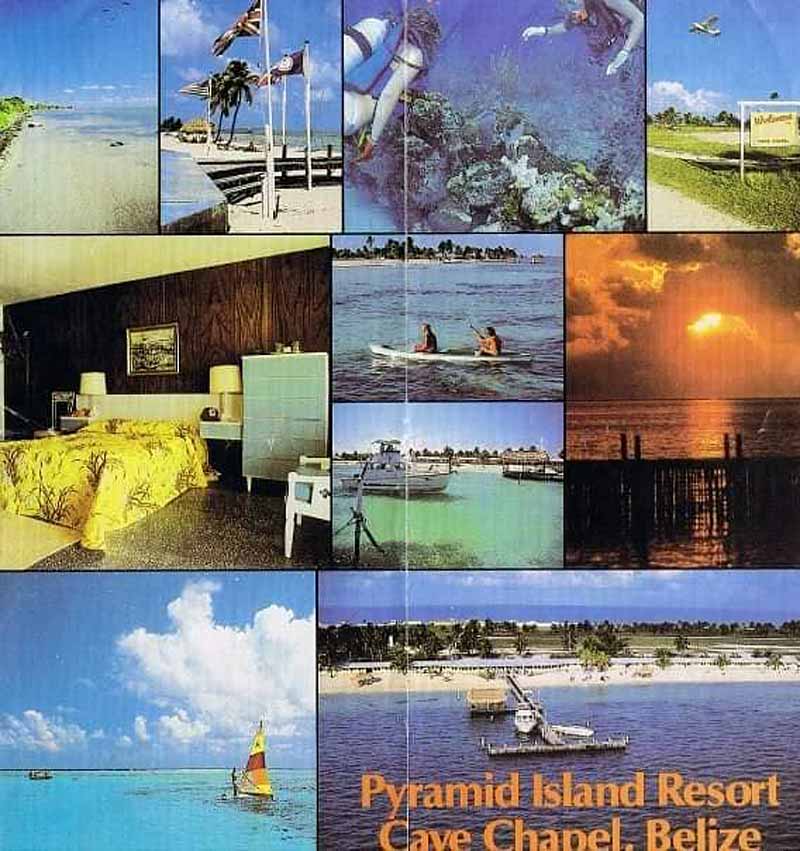
March, 1992. Photo courtesy Wayne Gregory.

March, 1992. Photo courtesy Wayne Gregory.
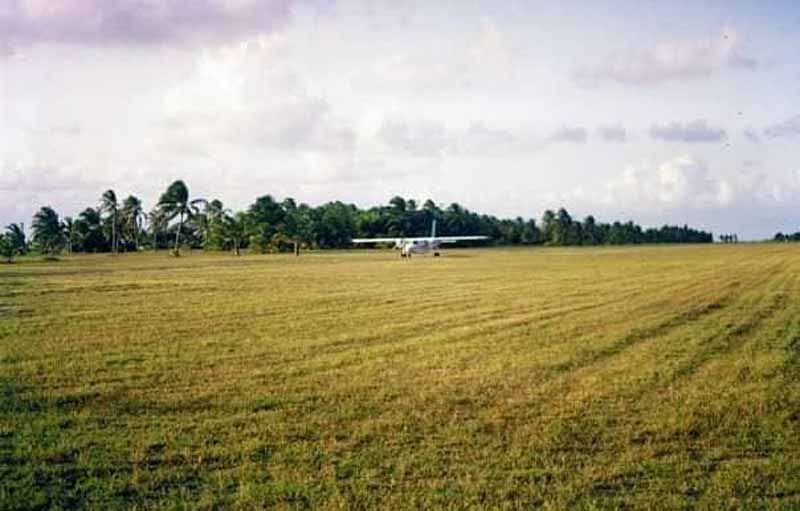
March, 1992. Airstrip at Caye Chapel, photo by Wayne Gregory.

March, 1992. Photo by Wayne Gregory.
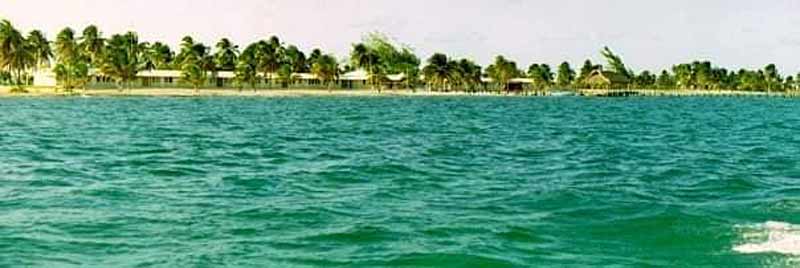
March, 1992. Photo by Wayne Gregory.

When the airstrip was built, it took 3500 concrete bags to mix with the sand and silt for the airstrip to harden on top.
 Pyramid Island Resort, early 1980's. Caye Chapel was once owned by Isaiah Morter. Plus a little history of Morter "The Coconut King," Belize's first black millionaire
Pyramid Island Resort, early 1980's. Caye Chapel was once owned by Isaiah Morter. Plus a little history of Morter "The Coconut King," Belize's first black millionaire
Vintage Caye Chapel before the commercialization of the island. They had great beach parties there and delicious club sandwiches at the restaurant. That was like Belize’s own lee Country Club.
That dive boat was the Ensign 40 and in use in early 80's. The southern part of the island was marked as having Mayan archaeological remains, though not sure of the extent of the site or if it ranges from bones, altar, or something more.
Isaiah Morter, our first black millionaire, owned the island of Caye Chapel where he planted coconuts. He did not sell it. He gave it to the Marcus Garvey Movement in New York and they apparently sold it. There was a long fight over whether UNIA Belize owned it or if the gift was to UNIA, the parent organization. Nurse Cleopatra White mentioned that she had tried to get Belizean lawyers, Dean Lindo and Joseph Gray to represent UNIA Belize.
Mr. Larry Addington owed Caye Chapel for years in the 80's. He built the golf course.
Wayne Gregory:
I spent most weekends there and the staff were looked after from what I saw and what I got to see. Smithy was in his 60s and ran the marina and maintenance and stuckout in my mind.
Kim Bradley Thayer:
So many weekends, summers, Easters spent here in the 70’s and 80’s as Dad was the Manager of Operations. Mr. Addington owned it at the time, nice man, cared about his employees and loved his island. He passed away a few years ago. I knew Smithy from when he worked for Fred Good at St. George’s Caye. He was a curmudgeon! I loved talking to him, brilliant man.
Jorge Rosales:
Mr. Addington passed away in 2015 of throat cancer, he was a a very nice person giving jobs to Belizeans since I know of from 1991 to 2007 or 2008. I helped build Caye Chapel from 1992 to 2005 on the construction area together with my chief or manager the Ringgolds.
Coconut was so valuable because they used all of it. They did not throw away any of it and the islands at that time had an abundance of the trees. Copra was one of Belize's first exports starting in the 1860s. One of those involved in the export of coconuts was the Heusner family, who had a cocal on Ambergris Caye. The first small export of sugar was 1857 by Yucatecan refugees. Coconuts was a huge business in the late 1800s n early 1900s. The big deal was they used the coconuts to make soap.
Nick Pollard: Turneffe became a huge supplier and ships came for the dry nuts as well as Stann Creek. My grandfather Hoffmann had over 200 acres planted out in the Valley and supplied the buyers. This was an industry for which little information is available.
Mike Heusner:
Once when I was the manager at Caye Chapel we had a big party for a special ocassion and Richard Ysaguierre and Brads Pattico were the musicians. These two very talented individual artists insisted on playing separately. I finally persuaded them to play one piece together. And they did for a little while, but it did seem a little confusing. Then they both stopped playing and Brads asked, "Richard, which key are you playing in?" Richard answered: "Caye Chapel".
Caye Chapel was the location for the making of the movie 'The Cay' starring James Earl Jones. The storyline was a twist on the book 'Robinson Crusoe' with the main character being black (Jones) and Man Friday being a little white boy. The movie was filmed in the early 70's.
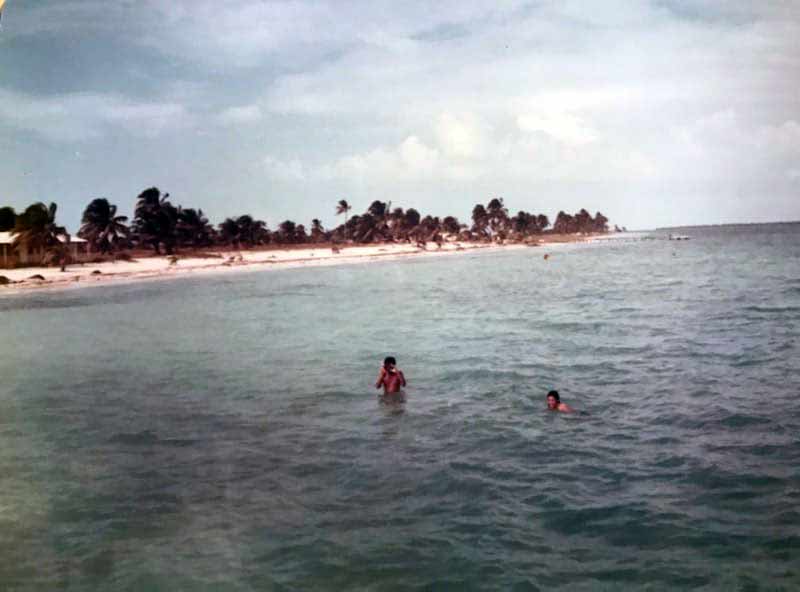
Photo by Adrian Cain.
Adrian Cain:
I remember spending many vacations out here throwing darts and playing ping pong. A sunken barge was under the area of the dock with the thatch - guaranteed to have lobster.
Richard Price:
There is still a sunken/submerged barge on the leeward side of the island (west), next to where the old cargo loading dock was and where the entrance to the 'new' marina is now. Adrian is presumably referring to one in front of the hotel, that is no longer there.
Hector Silva:
CAYE CHAPEL was first owned by Black Millionaire Isaah Morter, a large Coconut exporter, who also donated Liberty Hall. The Estate remained silent until in the late 1950, a fish trader, Ed Dvorak showed some interest and he began negotiating for a buyer. Among them was SAMMY DAVIES Jr. In 1965, as the Minister of Civil Aviation, I received an application, through Mr Leopold ( Poly ) Balderamos for a Licence to open an Airstrip on that Island. After much inspection and investigation, a permit was given on condition of a National Security Measures (Lock the Airstrip when not in use by the Company.). Bones were found on the Southern End and speculation was wide, that they were bones from the many retreating Spaniards who lost at the Battle of St George's Caye, and were dying of cholera.
Kim Bradley Thayer:
My dad, Tito Bradley, was the operations manager and dive master there for over 10 years. I spent many a summer there working. Fun days and nights there. They had the best New Years Parties !!! My dad worked for Larry Addington. Dad ended up retiring from there as he had a double bypass
Anthony Westby Sr.:
My dad Charles Westby worked on Caye Chapel for Ed Dvorak we passed Hurricane Hattie there October 1961, a terrible experience for twenty two of us including workers.
Jose Gomez:
The best beach parties ever were held at Caye Chapel with the Messenger band.
Isaiah Emmanuel Morter
 Isaiah Emmanuel Morter (sometimes spelled Isiah) (1860 – 7 April 1924) was born in 1860 in the Freetown district of Belize. He was of Igbo descent (some say his parents were Ashanti royalty) coming from a line of slaves brought to America from Nigeria. Marcus Garvey wrote that "Morter grew up fighting the oppositions and difficulties generally surrounding one born to his condition, until he lifted himself to the highest pinnacle of service to his race and to his country."
Isaiah Emmanuel Morter (sometimes spelled Isiah) (1860 – 7 April 1924) was born in 1860 in the Freetown district of Belize. He was of Igbo descent (some say his parents were Ashanti royalty) coming from a line of slaves brought to America from Nigeria. Marcus Garvey wrote that "Morter grew up fighting the oppositions and difficulties generally surrounding one born to his condition, until he lifted himself to the highest pinnacle of service to his race and to his country."
By planting and growing bananas and coconuts, Morter built a fortune and is widely regarded as Belize's first coloured millionaire. His nicknames included "the Coconut King" and "Guinea Sigar" and he owned Caye Chapel and other plantations. For his achievements he was honoured with the award of Knight Commander of Distinguished Service Order of Ethiopia. He was also a strong supporter of Marcus Garvey's Universal Negro Improvement Association.

Morter died on 7 April 1924.
A statue of Morter can be found at the end of Albert Street, near St. John's Cathedral, in Belize City on Albert Street West. The statue itself was created by the late sculptress/artist Vilma Romero of Corozal Town. Vilma has sculptures on permanent public display throughout the country. She really should be honoured as a Belizean Patriot. He is not widely known today by the public in Belize.
He left his estate to the UNIA, and when he died their was litigation over the estate by two factions of the UNIA. A few years after Marcus Garvey was deported to Jamaica in 1927, the UNIA split into two factions. One of the UNIA factions was led by the Trinidadian doctor Lionel Francis, who moved to Belize in the 1940s and ended up being a beneficiary of what Morter had left for the UNIA. IN 1950 he was one of the founders of the National Party, along with William Harrison Courtenay. A resident of Foreshore, Francis died in Hurricane Hattie. The whole Morter estate legal issue was headline news in the UNIA newspaper The Negro World.
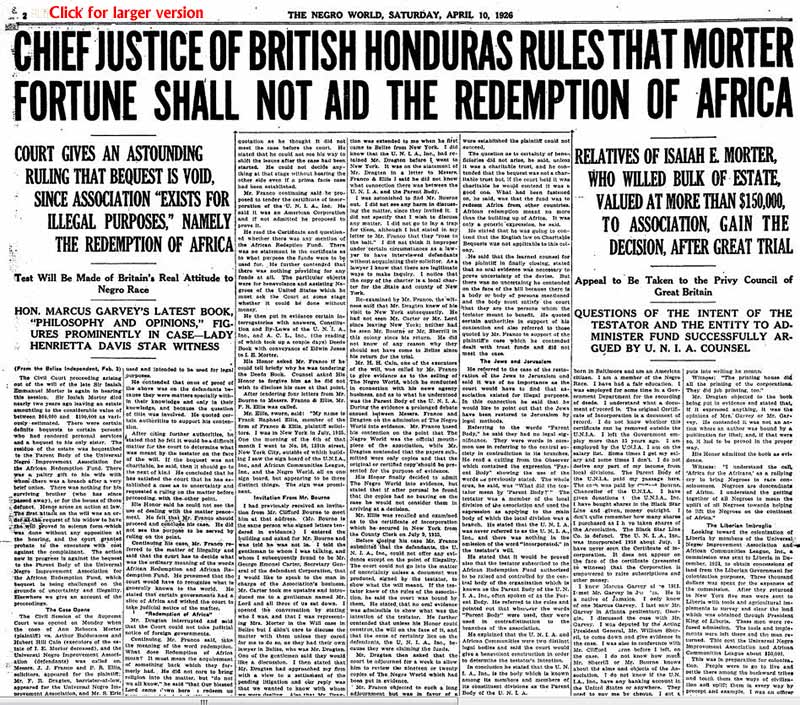
(Reprint from Negro World, April 29, 1924)
Sir Isaiah Morter, Knight Commander of the Distinguished Service Order of Ethiopia, another Prince of Africa, has fallen. He, to us as a race, is physically dead, but, spiritually, to us he lives. It is not every man who cometh into the world who lives forever. The absence of the millions who pass away is generally never observed, because their deeds for the good of humanity, their race and their nation were never registered. And oft-times no attempt was made to serve any but themselves. But not so with Isaiah Emanuel Morter, of Belize, British Honduras, Central America, He was a Negro of lowly parentage, who grew up fighting the oppositions and difficulties generally surrounding one born to his condition, until he lifted himself to the highest pinnacle of service to his race and to his country. In his mature years, after he had honestly accumulated a fair portion of wealth, which he worked for and thriftily secured, he became identified with movements for the uplift of his race, notably among them the Universal Negro Improvement Association, of which he was a staunch member and supporter.
He, unlike the majority of Negroes who accumulate wealth. did not seek to find association socially and otherwise among other races, but lie was satisfied to confine his success to his race and give his race credit for everything that he accomplished. Most West Indian and Central American Negroes, whenever they accumulate wealth, generally seek to dissipate it either by marriage into the white race, or by fawning before the social patronage of that race, which generally seeks rather to deprive them of their wealth than to accept them as social equals and members of their fraternity.
Sir Isaiah Morter was true to his race, and has written his name down as the first of that successful type of Negro who did not forget Africa and its relationship to the rest of the Negroes throughout the world. Not very long ago Sir Isaiah Morter came to New York for the benefit of his health, and the writer had the honor of entertaining him at his home, where he remained a guest for several weeks. It was during the period when the Universal Negro Improvement Association was being hunted by its enemies, in the height of the trial of the celebrated "Black Star Line" case. The injustices done to the Association, and the subject of the enemies' design were so marked that Sir Isaiah Morter felt (as all Negroes did who read and followed the case), that it was not a fight against an individual, but a fight against the race. He became even more impressed then with the work and usefulness of the Universal Negro Improvement Association than he was before. Unfortunately, his health continued failing him, even though he experienced a marked improvement during his stay in America. He returned to Belize. his native home, and there he lingered for several months, until the grim reaper Death visited him on the 7th instant. His memory lives among the members of the Universal Negro Improvement Association and the Negro race forever. Prior to his death, nothing in the world was as dear to him as the principles of the Universal Negro Improvement Association, and as a proof of his attachment to the movement and his desire to help it, he has become the first great benefactor of the cause of African Redemption. In his will he bequeathed to the Universal Negro Improvement Association, for African Redemption, nearly two-thirds of his entire fortune, to the extent of between $75,000 and $100,000.
This is the first large bequest that has been given to the Association. It is a fair indication of the loyalty of the members of this great movement. If other Negroes in America and the West Indies will follow the example of Sir Isaiah Emanuel Morter in assisting to make the Universal Negro Improvement Association what it ought to be, then in a few years not only will Africa be redeemed, but the whole Negro race will be elevated to a position of world recognition. Formerly, Negroes were disposed to die and leave their fortunes for white friends and white institutions and some died without making wills at all...
Below is a March 10, 1928 Negro World article on the Morter estate case. The article includes two short letters by W. Harrison Courtenay and Samuel Haynes.
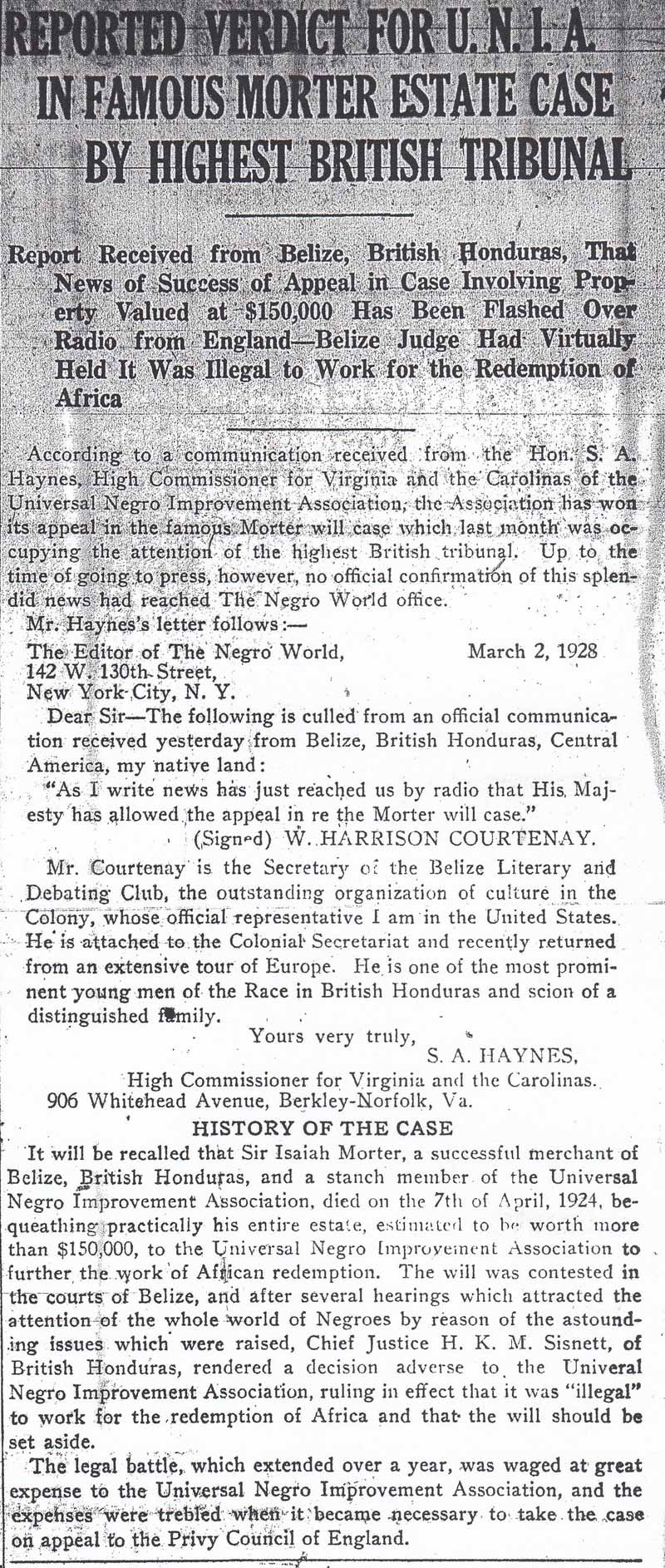
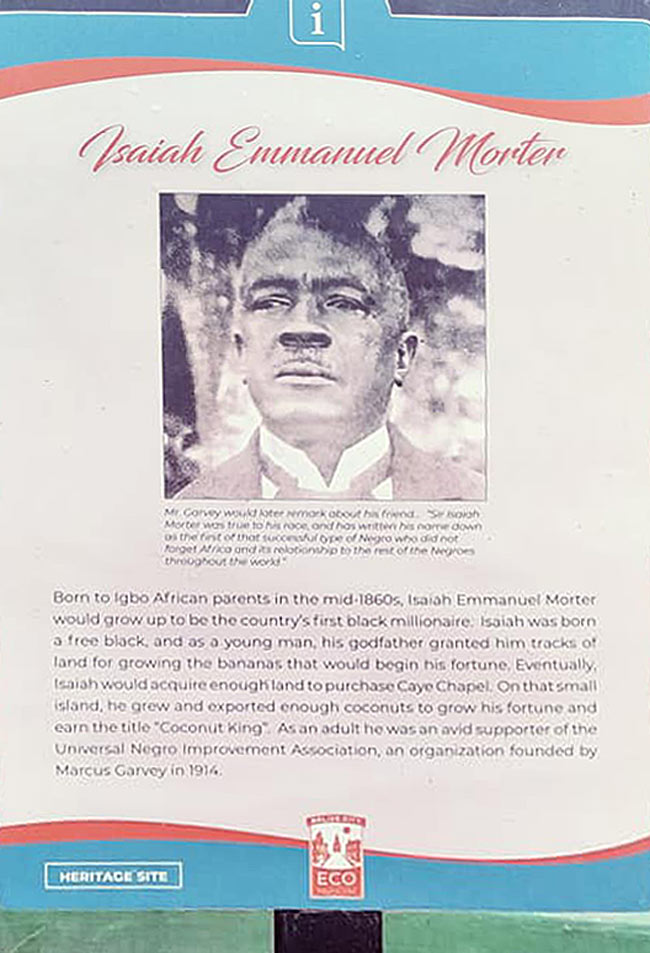
Plaque in Yarborough Cemetery, photo by Eden Cruz.
Click here to comment on this picture.

Click here for a list of previous pictures of the day
Click here for a large selection of photographs and videos of Belize
 Email us - We Email us - We your photographs. Send us yours with a description! your photographs. Send us yours with a description!
 Belize Search.com
Belize Search.com  Belize News.com
Belize News.com  Belize Cards.com
Belize Cards.com  Belize History
Belize History  IslandBazaar.net
IslandBazaar.net  Belize Weather
Belize Weather 
 Belize Lodging
Belize Lodging  Tours & Recreation
Tours & Recreation  Diving & Snorkeling
Diving & Snorkeling  Fishing
Fishing  Travel Tips
Travel Tips  Real Estate
Real Estate 
 AmbergrisCaye.com
AmbergrisCaye.com  Island Information
Island Information  Visitor Center
Visitor Center  Belize Business
Belize Business  San Pedro Sun
San Pedro Sun 
 SanPedroDaily.com
SanPedroDaily.com  Belize Message Board
Belize Message Board  Restaurants
Restaurants  Things to do
Things to do 
|